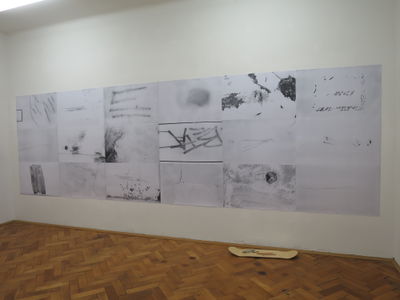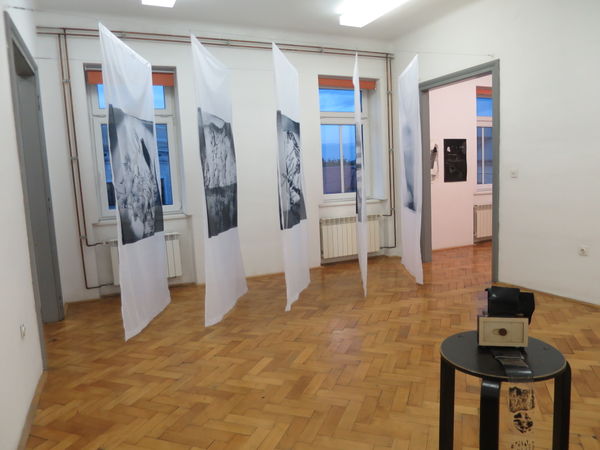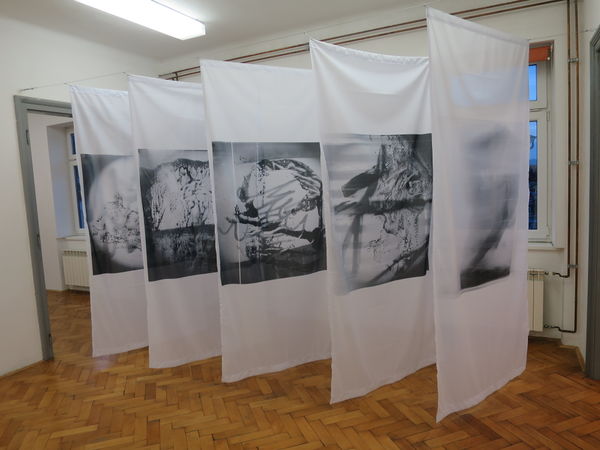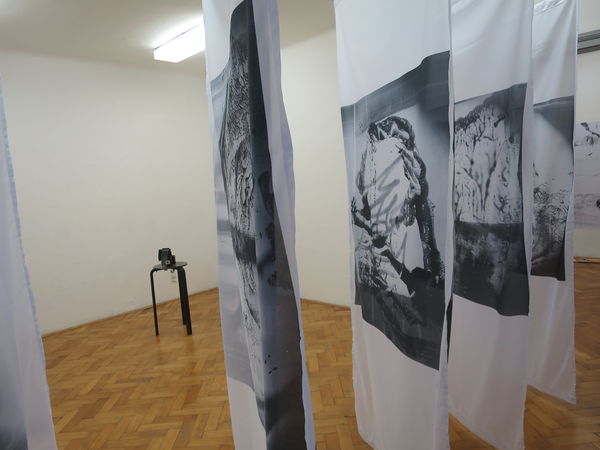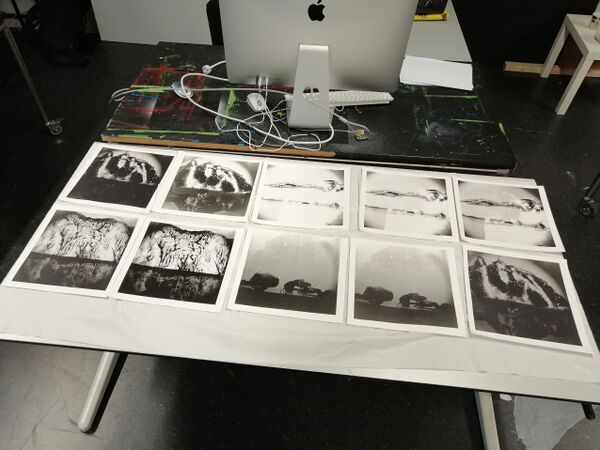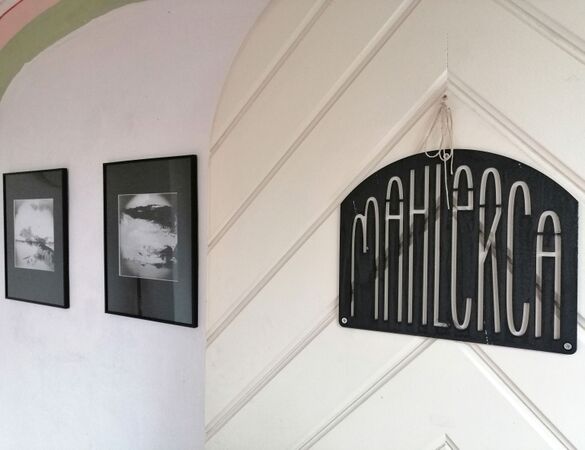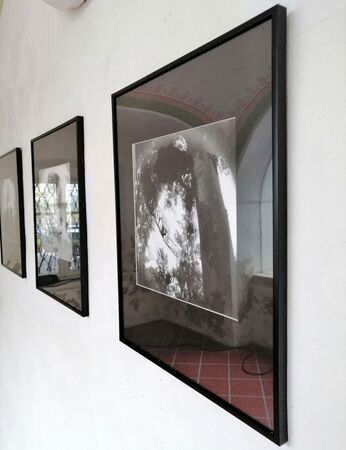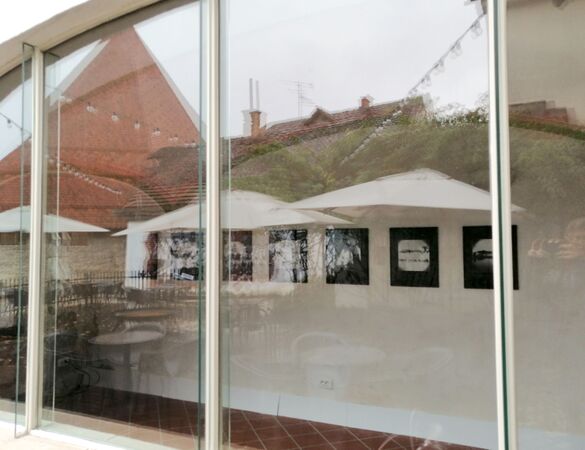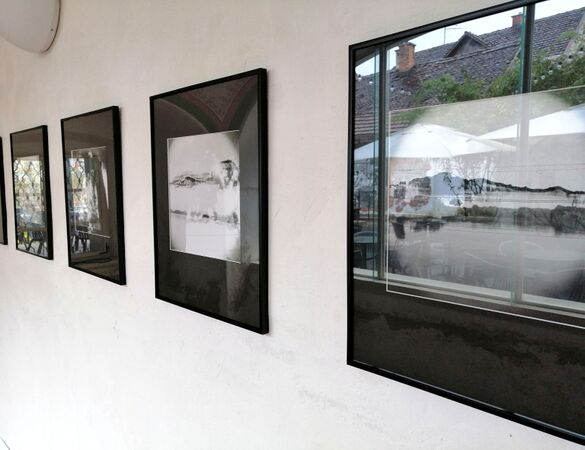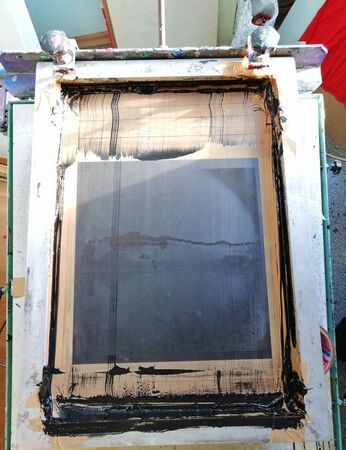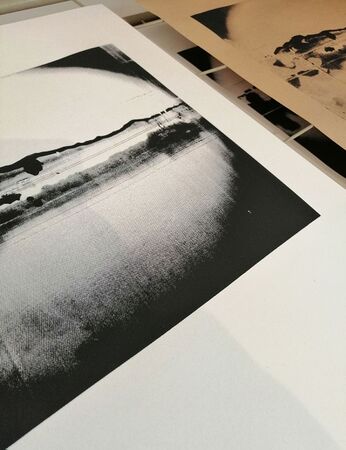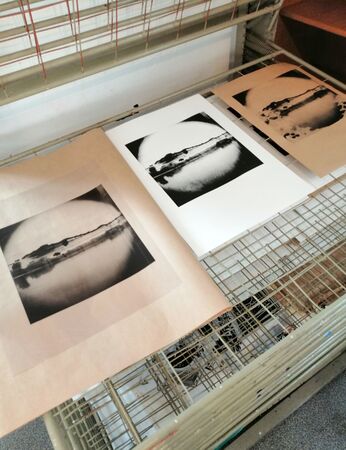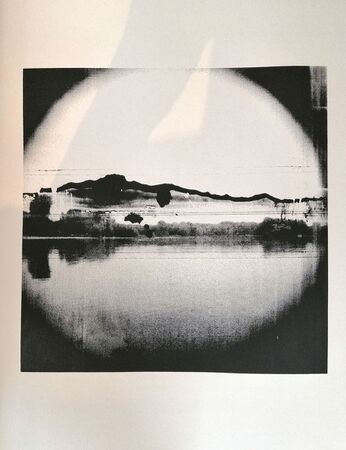Mia/PROTOTYPES: Difference between revisions
No edit summary |
|||
| (9 intermediate revisions by the same user not shown) | |||
| Line 1: | Line 1: | ||
[[Mia/Project_proposal#Project_proposal_FINAL_TEXT_.2810._11._2019.29|Back to PROJECT PROPOSAL]] | |||
[[User:Mia|Back to Mia Paller]] | |||
==PROTOTYPE wallpaper (Hiša kulture v Pivki, Slovenia)== | ==PROTOTYPE wallpaper (Hiša kulture v Pivki, Slovenia)== | ||
Thinking about different ways to present the photographs of the Trace series, led me to try it out with the wallpaper, which was on show in a gallery Hiša kulture v Pivki (Slovenia). When designing the wallpaper, I decided for a blow-up of my 35 mm analogue photographs to the size of 90x57 cm. What I like about this magnification is that fragments of reality that usually remain unnoticed, acquired the status of important images and are thus asking for viewer’s attention and analysis. Secondly, the gesture means a transfer from public (urban) environment to the interior (closed) gallery space, which was, in this case in a rather rural region of Slovenia. However, in the exhibition I realised I should pay more attention to the kind of print I make (quality, contrast etc.) and that I need to use the material strong enough to be glued with wallpaper glue, as I want the photographs to really become a part of the exhibition wall (which was not the case as they were wall-mounted on several spots instead of all over the surface). | Thinking about different ways to present the photographs of the Trace series, led me to try it out with the wallpaper, which was on show in a gallery Hiša kulture v Pivki (Slovenia). When designing the wallpaper, I decided for a blow-up of my 35 mm analogue photographs to the size of 90x57 cm. What I like about this magnification is that fragments of reality that usually remain unnoticed, acquired the status of important images and are thus asking for viewer’s attention and analysis. Secondly, the gesture means a transfer from public (urban) environment to the interior (closed) gallery space, which was, in this case in a rather rural region of Slovenia. However, in the exhibition I realised I should pay more attention to the kind of print I make (quality, contrast etc.) and that I need to use the material strong enough to be glued with wallpaper glue, as I want the photographs to really become a part of the exhibition wall (which was not the case as they were wall-mounted on several spots instead of all over the surface). | ||
| Line 22: | Line 27: | ||
For this exhibition I chose a rather classical approach to showing my Drawing Camera pictures, presenting them framed on the wall. I used this opportunity to prepare ‘proper’ silver-gelatine prints on fibre-based paper, making a small edition of 2-3 prints of each selected negative. I described the process and its importance to me in the project proposal already so hereby, I will focus on rather strategic, yet important aspects. The decision to make prints myself motivated me firstly to learn how to work with fibre-based paper (it being more delicate and the process slightly more complicated than regular resin-coated paper). Secondly, I became more conscious about that happens with the negative and the picture, once it is printed, especially in terms of reproduction. I faced the questions such as how to properly sign the prints, what does an edition actually mean (if I print more pictures from the same negative and change the size, is it a new edition, am I allowed to reprint pictures later if now I decided to only make 3 copies of each etc.). Most of these questions I already encountered in printmaking (say, etching) so when explained to me, I really felt the tight relation between the two - not only visually and in process-wise, but even in terms of the system-context to which these pictures belong technically. Having the pictures become objects I tried to sign, I suddenly realised I need to assign them titles (which in digital formats was never necessary, as I could find, reuse and rename the files…). I decided to pay more attention to archiving (digital and analogue) and to be more decisive and consistent with titling and recordkeeping. | For this exhibition I chose a rather classical approach to showing my Drawing Camera pictures, presenting them framed on the wall. I used this opportunity to prepare ‘proper’ silver-gelatine prints on fibre-based paper, making a small edition of 2-3 prints of each selected negative. I described the process and its importance to me in the project proposal already so hereby, I will focus on rather strategic, yet important aspects. The decision to make prints myself motivated me firstly to learn how to work with fibre-based paper (it being more delicate and the process slightly more complicated than regular resin-coated paper). Secondly, I became more conscious about that happens with the negative and the picture, once it is printed, especially in terms of reproduction. I faced the questions such as how to properly sign the prints, what does an edition actually mean (if I print more pictures from the same negative and change the size, is it a new edition, am I allowed to reprint pictures later if now I decided to only make 3 copies of each etc.). Most of these questions I already encountered in printmaking (say, etching) so when explained to me, I really felt the tight relation between the two - not only visually and in process-wise, but even in terms of the system-context to which these pictures belong technically. Having the pictures become objects I tried to sign, I suddenly realised I need to assign them titles (which in digital formats was never necessary, as I could find, reuse and rename the files…). I decided to pay more attention to archiving (digital and analogue) and to be more decisive and consistent with titling and recordkeeping. | ||
<gallery heights=300px mode="packed-hover" caption="Prints for the exhibition Photoupsets, 5. - 30. 11. 2019"> | |||
File:prints drawing camera.jpg | |||
File:razstava foto1.jpg | |||
File:razstava foto2.jpg | |||
File:razstava foto4.jpg | |||
File:razstava foto5.jpg | |||
</gallery> | |||
[[Mia/Photoupsets_(exhibition_in_Kranj,_SI,_2019)|See the wiki page about the exhibition here]] | |||
==PROTOTYPE screenprints (Hiša kulture v Pivki, Slovenia)== | ==PROTOTYPE screenprints (Hiša kulture v Pivki, Slovenia)== | ||
| Line 29: | Line 41: | ||
<gallery heights=300px mode="packed-hover"> | <gallery heights=300px mode="packed-hover"> | ||
File:sitotisk pivka1.jpg | |||
File:sitotisk pivka3.jpg | |||
File:sitotisk pivka2.jpg | |||
File:sitotisk pivka4.jpg | |||
</gallery> | </gallery> | ||
Latest revision as of 19:27, 10 November 2019
PROTOTYPE wallpaper (Hiša kulture v Pivki, Slovenia)
Thinking about different ways to present the photographs of the Trace series, led me to try it out with the wallpaper, which was on show in a gallery Hiša kulture v Pivki (Slovenia). When designing the wallpaper, I decided for a blow-up of my 35 mm analogue photographs to the size of 90x57 cm. What I like about this magnification is that fragments of reality that usually remain unnoticed, acquired the status of important images and are thus asking for viewer’s attention and analysis. Secondly, the gesture means a transfer from public (urban) environment to the interior (closed) gallery space, which was, in this case in a rather rural region of Slovenia. However, in the exhibition I realised I should pay more attention to the kind of print I make (quality, contrast etc.) and that I need to use the material strong enough to be glued with wallpaper glue, as I want the photographs to really become a part of the exhibition wall (which was not the case as they were wall-mounted on several spots instead of all over the surface).
Presentation video of the exhibition
PROTOTYPE Drawing Camera pictures (Hiša kulture v Pivki)
While thinking about the material to embody the images made with Drawing Camera, I got fascinated by large scale prints on fabric and paper I saw in Witte de With Centre for Contemporary Art at the exhibition of Rosella Biscotti. I could imagine my pictures to be printed on translucent fabric or semi-transparent paper (such as washi or tracing paper). Mainly because transparencies are already inherent in these pictures (plastic foil, shots through the glass etc.), I wanted to pronounce (or tautologically repeat) this layering with the material they are printed on. I ordered five prints on 115g polyester (commercially used for flags), as it is slightly see-through, and the prints are almost equally visible from both sides. For the exhibition in Pivka, I decided to make a corridor connecting two entries of the room, in a way that images overlap, and the viewer has an inkling of the images behind the front one. I found this spatial arrangement beneficial, as the visitors had to actively observe the work by moving around and through it, discovering it layer by layer.
- (photos: Leon Zuodar)
PROTOTYPE Drawing Camera pictures (solo exhibition Photoupsets in Mahlerca gallery, 5. – 30. 11. 2019; Kranj, Slovenia)
For this exhibition I chose a rather classical approach to showing my Drawing Camera pictures, presenting them framed on the wall. I used this opportunity to prepare ‘proper’ silver-gelatine prints on fibre-based paper, making a small edition of 2-3 prints of each selected negative. I described the process and its importance to me in the project proposal already so hereby, I will focus on rather strategic, yet important aspects. The decision to make prints myself motivated me firstly to learn how to work with fibre-based paper (it being more delicate and the process slightly more complicated than regular resin-coated paper). Secondly, I became more conscious about that happens with the negative and the picture, once it is printed, especially in terms of reproduction. I faced the questions such as how to properly sign the prints, what does an edition actually mean (if I print more pictures from the same negative and change the size, is it a new edition, am I allowed to reprint pictures later if now I decided to only make 3 copies of each etc.). Most of these questions I already encountered in printmaking (say, etching) so when explained to me, I really felt the tight relation between the two - not only visually and in process-wise, but even in terms of the system-context to which these pictures belong technically. Having the pictures become objects I tried to sign, I suddenly realised I need to assign them titles (which in digital formats was never necessary, as I could find, reuse and rename the files…). I decided to pay more attention to archiving (digital and analogue) and to be more decisive and consistent with titling and recordkeeping.
- Prints for the exhibition Photoupsets, 5. - 30. 11. 2019
See the wiki page about the exhibition here
PROTOTYPE screenprints (Hiša kulture v Pivki, Slovenia)
At the end of the exhibition in Pivka, the gallery offered a 1-day workshop of silkscreen printing. Artist Leon Zuodar prepared the screen from one of my Landscape photo-drawings of which we printed 20 copies (10 for the gallery and 10 for myself). The image was printed only with black ink (since it is a B&W photograph). Despite the graphic transformation inherent in the printmaking process, most of the details translated beautifully from photograph to the final print. Once printed in silkscreen, the drawn and photographed layer of the picture merged really well and become one condensed image, which I was very happy to see.

